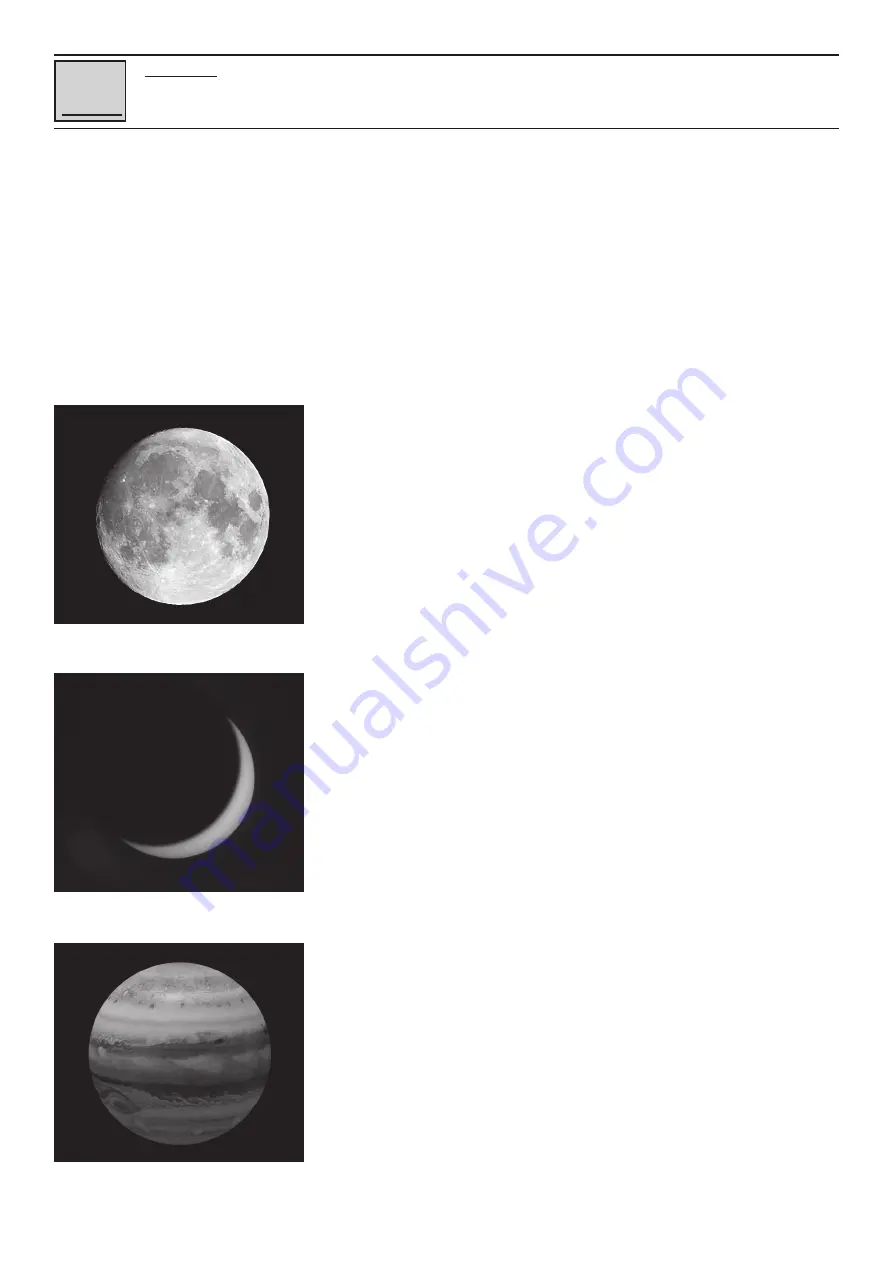
- 33 -
Appendix
VIII
Observation
You should allow about 90 minutes for the temperature adjustment before observing.
If the telescope is set up e.g. from a heated car or house on the free field, it can come
to a so called "Tubus-Seeing". This results from the main mirror not yet adapted to the
temperature difference.
Only after the temperature adjustment the telescope shows a sharp picture.
The first observations are best practiced during the day, so you will quickly become
familiar with the operation of your new telescope.
First select a simple object: a mountain top, a lighthouse or the like.
Roughly align the telescope to it.
Now target the target object with the light spot finder.
Now the object should already be visible in the 26mm eyepiece.
Now the image can be carefully focused with the eyepiece extension.
Now you can dare to go to the moon in the evening (if visible); the operation should be
easy even in the dark. The phases that are increasing and decreasing are best suited for
observing the moon, with their detailed shadow casts that allow crater formations and
the like to emerge very vividly. During the full moon the surface appears relatively low-
contrast and without structure.
For moon observation a neutral gray filter is recommended, which attenuates the partly
bright light. This is available as an accessory from your specialist dealer.
Spend a few nights observing the moon; it is very interesting to see how individual
formations such as mountains, craters and Mary change with changing phases of the
moon!
Planets
On their way around the sun, the planets constantly change their position in the sky.
Consult a monthly astro magazine (Interstellarum, Astronomy Today, Stars and Space)
to find planets in the sky or search the Internet. In the following you will find a list of the
planets which are particularly suitable for observation with the Messier telescope:
Venus
The diameter of Venus is about 9/10 of the diameter of the earth. While Venus orbits
around the Sun, the observer can follow how it constantly changes its light phases: Sickle,
half Venus, full Venus - very similar to what you are used to from the moon. The planet
disk of Venus appears white, because the sunlight is reflected by a compact cloud cover
that covers all surface details.
Mars
The diameter of Mars is about half the diameter of the earth. Mars appears in a telescope
as a tiny, reddish-orange slice. There's a chance you might spot a touch of white when you
look at one of the planet's two icy polar caps. Approximately every two years, additional
details and color effects become visible on the planet's surface. This happens whenever
Mars and Earth come closest to each other on their orbits.
Jupiter
The largest planet in our solar system is called Jupiter, its diameter is eleven times larger
than the Earth. The planet appears as a disk over which dark lines extend. These lines are
cloud bands in the atmosphere. Even at the lowest magnification, four of the 18 Jupiter
moons (Io, Europa, Ganymed and Callisto) can be recognized as "star-shaped" light points.
Because these moons orbit Jupiter, the number of visible moons may change over time.
Saturn
Saturn has nine times the earth diameter and appears as a small, round disc. His rings
protrude from both sides of this disc. Galilei, who in 1610 was the first man to observe
Saturn in a telescope, could not have foreseen that what he saw would be rings. He
thought Saturn had "ears." Saturn's rings consist of billions of ice particles, their size
probably ranging from the tiniest dust particle to the size of a dwelling house. The largest
The moon craters are good observation objects,
especially for beginners.
The planet Venus during the sickle-shaped phase.
The four inner ("Galilean") modes of the planet Jupiter
can be observed each night in a different position
Summary of Contents for MCX Goto Series
Page 30: ...30 Computerised Handset with LED display VII Fig 35...
Page 39: ...39...

































